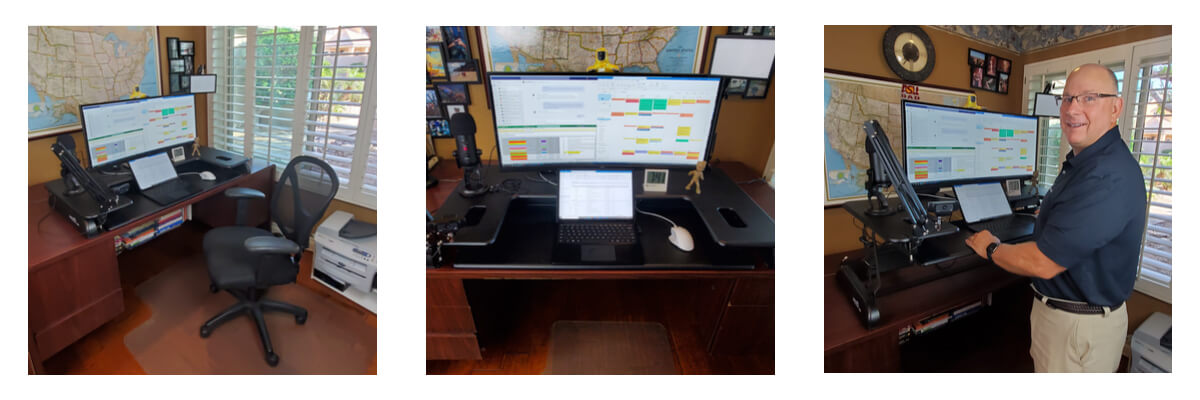90% of HR leaders have said employees would be allowed to work remotely
The COVID pandemic pushed every firm to adopt remote work at some level, and while there are signs of a gradual return to normalcy, remote work’s overall benefits are clear and will continue to be a significant part of the accounting profession’s next “normal” work environment.
With the reality that remote workers, whether full or part-time, provide a competitive advantage, it is important that firms wholeheartedly include remote work as an integral part of the firm’s evolving culture.
One of the difficulties identified by owners and managers throughout the adoption of remote work has been that many were not prepared to manage and collaborate with staff not physically within their line of sight.
Firm leaders must adapt their management style to ensure remote workers feel as supported as the individuals physically within the office.
Below we outline seven considerations to more effectively incorporate remote workers into your firm. Read through these considerations, then use the question(s) at the end of each section to identify which areas need improvement.
1. Rethink how performance is measured
Many owners learned to manage their practices based on staff “putting in the hours,” which they could physically confirm by seeing them working at their desks (and unfortunately, some noticing when they clocked in and left the office for the day.)
Combat this traditional clock-in/clock-out mentality by focusing production metrics on what is really important: The successful, timely completion of work and effective collaboration with clients and firm members.
Ask yourself:
- If I were to start managing my team today, which performance metrics would be most indicative of productivity, or lack thereof?
- Which metrics show how their actions are contributing to our business’s success?
2. Use a project management tool to assign and monitor tasks
Managing remote workers requires that all personnel integral to a project have comprehensive, timely awareness of its status and task deadlines.
Today, this means using a project or workflow tool that is always available at the end user’s convenience, which by default must be virtual. Managers must learn to effectively use these tools to assign and manage work and see that the end-users know how to utilize them.
Ask yourself:
- Does my team have an effective project management tool to capture, assign and monitor their workload?
- Does each member of my team understand how to use our project management tool?
- Are project processes defined and readily available?
3. Communicate regularly and respect team commitments
Regular staff meetings (that include remote workers) will maintain projects keep progressing and allow managers the opportunity to address and answer questions.
Whether teams meet weekly, daily, or as needed, managers need to be mindful of remote workers’ capabilities and schedule meetings accordingly so everyone can attend. Inclusion is important to promote camaraderie and will help enforce a collaborative culture throughout the firm.
Sticking to fixed time schedules for formal meetings respects attendees’ time constraints, which may be more stringent for remote and flex-time personnel due to parenting or location situations.
Ask yourself:
- How can our current meeting processes and schedules be tweaked to produce better outcomes and consistently promote a positive firm culture?
4. Build trust by trusting
“The best way to find out if you can trust somebody is to trust them.”
– Ernest Hemingway
One of the keys to managing remote workers is to build trust by establishing work expectations and then allowing the remote worker to complete that work without micromanaging every step of the process. While new hires may need more guidance, managers need to trust that their remote workers can manage and motivate themselves (until proven otherwise.)
Managers should also consider setting up casual check-ins to build rapport with employees. Discussing career goals, growth plans and overall wellness with employees will further help build trust.
Ask yourself:
- How often should we meet to ensure work, personal growth, and career goals progress?
5. Equip your team with remote access technology
A recent Gartner poll found that poor technology was the biggest barrier hindering effective remote work.
Firm leaders must ensure remote workers have the tools and system performance they need to complete their work, regardless of where they choose to complete that work. Here’s a peek into how my workstation is set up at home:

Adequate remote work setups include:
- Workstation: Multiple or oversized monitors, mouse, keyboard, etc.
- Peripheral equipment: Scanner, video camera, headset, etc.
- Internet bandwidth: Your internet bandwidth must be strong enough to access firm data and applications, stream webinars, attend virtual conferences and participate in video conference calls.
- Remote access platform: Employees’ access to firm data and applications is essential; employees’ secure access to firm and data and applications is critical. Find out how cloud hosting enables remote work.
Right Networks Cloud Premier is our IT outsourcing solution created specifically for accounting firms. In addition to firm IT management, the enterprise-level service provides a robust cloud portal for firms to manage and launch applications, send secure messages to teammates, and so much more.
And for firms (or any business) interested in the cloud’s security and reliability but aren’t looking to outsource all of their IT, Right Networks also provides cloud hosting solutions for accounting and tax software.
Ask yourself:
- Is my firm using a cloud hosting solution to manage access to applications, software and data?
- Could any firm processes be improved with an update to existing technology?
- Is it time to invest in new technology or remote access tools?
6. Provide consistent, accessible and thorough training sessions
Managers must provide consistent, accessible and thorough training to everyone they oversee, whether in the office or working remotely.
Consistent training sessions ensure all employees are held accountable for the same processes.
Learning curriculums have to be updated to ensure remote workers have access to the same training sessions and sessions must be recorded for those that cannot attend them live.
With both firms and clients increasingly utilizing virtual communication solutions, like Zoom and Microsoft Teams, firms should expand their curriculum to include collaboration tool training.
Ask your team what they are struggling with or what they are most interested in, then cater your curriculum to their needs. Possible topics include:
- How to set up and invite employees and clients to a virtual meeting
- How to add team members to a meeting that has already started
- How to share one application, documents or your your entire screen
- How to promote participation during meetings
Growing these soft skills will make personnel more confident, successful and help enforce practice growth.
Ask your team:
- Is there any program, software or tool you are struggling with or would like to learn more about?
Ask yourself:
- How can I enhance my team’s knowledge and capabilities to make the firm more successful?
7. Celebrate events and team accomplishments
Including remote workers in the firm’s successes and office social activities helps build firm culture, so it is important to ensure they are a regular part of these activities.
Announcing accolades in a firmwide setting makes everyone aware of all team members’ contributions and offers employees a chance to learn more about each other.
Was a new client acquired, did your teammate complete a project, or did you witness your child making their first soccer goal? Celebrate!
Here are some examples of how you can incorporate remote and on-premises employees’ achievements and enforce a fun, united culture:
- Send firm-branded swag (sweatshirts, notebooks, pens) in advance of important meetings
- Create a standard birthday care package to send to each employee on their birthday
- Send out goodies to celebrate St. Patrick’s Day, Fourth of July, Thanksgiving, etc.
Ask yourself:
- What can we do to make sure everyone working here feels like part of the team?
Proactivity produces productivity
While no one can be sure when this COVID pandemic will end, we can be sure of this:
Remote workers’ productivity is integral to your accounting firm’s future.
And without teamwide camaraderie, a united culture and the technology to bring everyone together, employees’ motivation…and productivity…will suffer.
Proactively taking time to think about what will create a strong culture and improve your team’s productivity is the first step in making it a reality.

